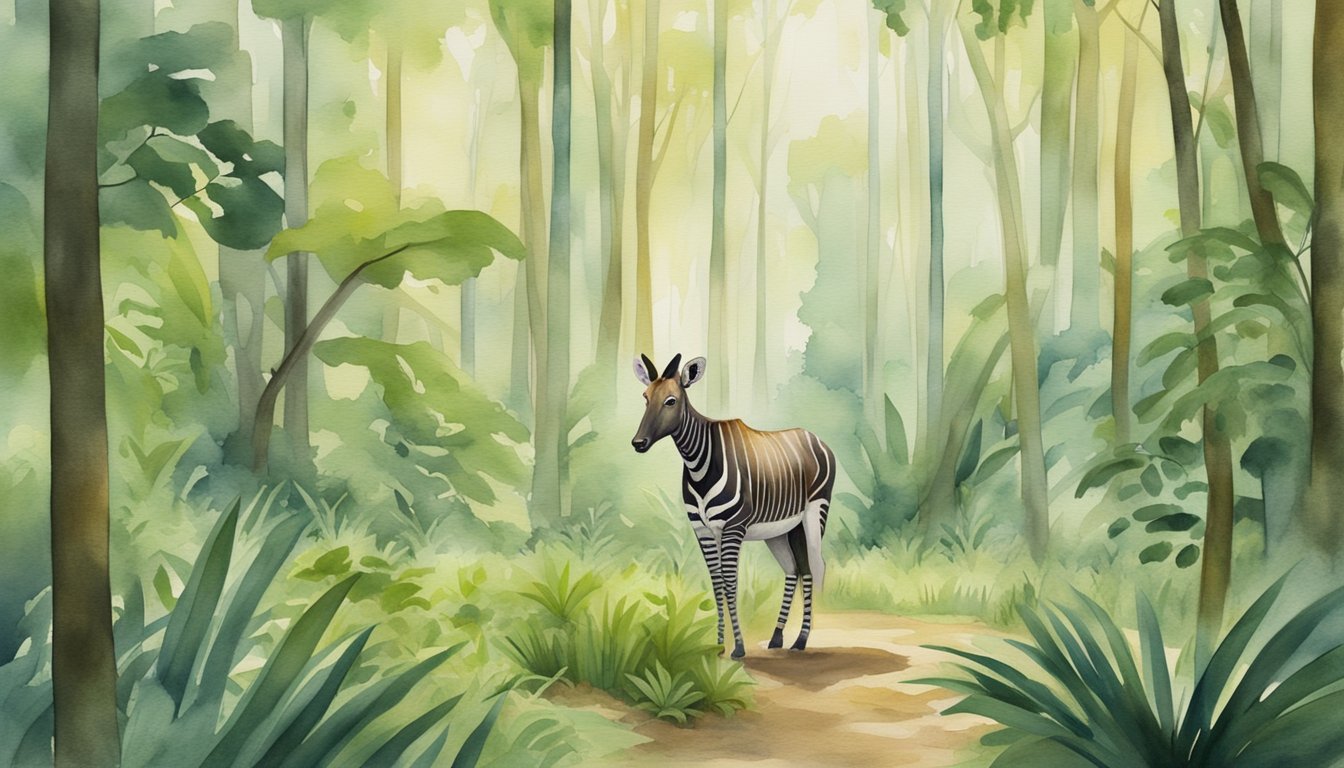Okapi Essentials
The okapi is a fascinating and distinctive mammal, closely related to the giraffe yet often mistaken for having a zebra lineage due to its striped coat. Understanding its unique features, from the prehensile tongue to its elusive nature, offers a glance into the rich tapestry of Earth’s biodiversity.
Physical Characteristics
The okapi exhibits a stunning chocolate to reddish-brown coat contrasted by horizontal white stripes on the legs, providing camouflage in the dappled light of the rainforest. They feature large ears and a long, flexible prehensile tongue, extending approximately 14 to 18 inches to help them strip leaves and buds from trees. Adult okapis generally weigh between 200 to 350 kilograms and stand approximately 1.5 meters tall at the shoulder.
Scientific Classification
In the animal kingdom, okapis belong to the kingdom Animalia, phylum Chordata, class Mammalia, order Artiodactyla, family Giraffidae, genus Okapia, and the species is named Okapia johnstoni. The Giraffidae family outlines their close relation to giraffes, despite their notable physical differences.
Natural Habitat
The elusive okapi inhabits the dense rainforests of Central Africa, predominantly within the Ituri Forest of the Democratic Republic of Congo. This species thrives in the dense vegetation, which offers ample food and protection from predators.
Diet and Foraging
Okapis have a herbivorous diet, consuming a mix of leaves, buds, fruits, twigs, and fungi. The animal’s prehensile tongue allows it to reach high branches and deftly select its preferred vegetation, supplementing its diet with clay to gain essential minerals, which is a process recognized by researchers.
Behavioral Traits
Okapis are known for their shy and solitary nature, although they may be diurnal or nocturnal. They maintain territory marked by scent glands that release a tar-like substance and use urine to communicate with other okapis. They rely heavily on their acute hearing to sense the presence of predators and other threats in their environment.
Reproduction Cycle
Female okapis have a gestation period of around 14 to 16 months, culminating in the birth of a single calf. These mammals typically enter a period of rut once a year, and after birth, calves are usually hidden for months before joining their mother in foraging.
Cultural Significance
Since its discovery by the Western world in the early 20th century with the help of the Zoological Society of London, the okapi has held our fascination and symbolizes the undiscovered mysteries of nature. Conservation efforts by various organizations, including the San Diego Zoo, focus on protecting the okapi, often referred to as the forest giraffe or Congolese giraffe, from habitat loss and poaching.
Conservation Efforts

Conservation of the okapi, an elusive herbivore native to the Democratic Republic of the Congo, necessitates a multifaceted approach due to the dire threats it faces. Various organizations, along with local communities, are actively involved in preserving this unique species, listed as Endangered on the IUCN Red List of Threatened Species.
Threats to Survival
The primary threats to the okapi’s survival include poaching for bushmeat and skin, habitat loss due to logging, mining for minerals and salts, and expanding human settlement. Predators like leopards also pose a significant risk to okapi populations.
Protective Measures
Protective efforts for the okapi include anti-poaching patrols and the establishment of protected areas like the Okapi Wildlife Reserve. Organizations such as the Okapi Conservation Project work tirelessly to implement these measures and enforce wildlife protection laws.
Population and Range
Okapis are endemic to the Ituri Rainforest in the Democratic Republic of the Congo. Exact population numbers are difficult to determine due to their reclusive nature, but it is known that their range and population density are declining.
Okapis in Captivity
Zoos around the world house okapis and participate in captive breeding programs, which play a role in education and global conservation efforts. These programs are also important for maintaining genetic diversity.
Community Involvement
Empowerment of local communities is critical for okapi conservation. Projects that provide alternative livelihoods help reduce reliance on activities like illegal logging and hunting, which are detrimental to okapi habitats.
Research and Knowledge
Continuous research is crucial for okapi conservation. It helps to better understand the species’ needs and habits, resulting in more effective conservation strategies. Collaborative efforts between international researchers and local experts are increasingly important for this type of research.

